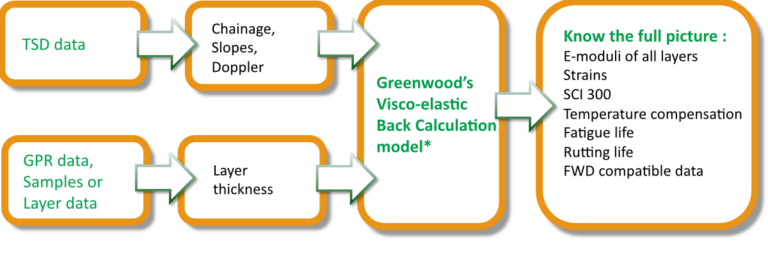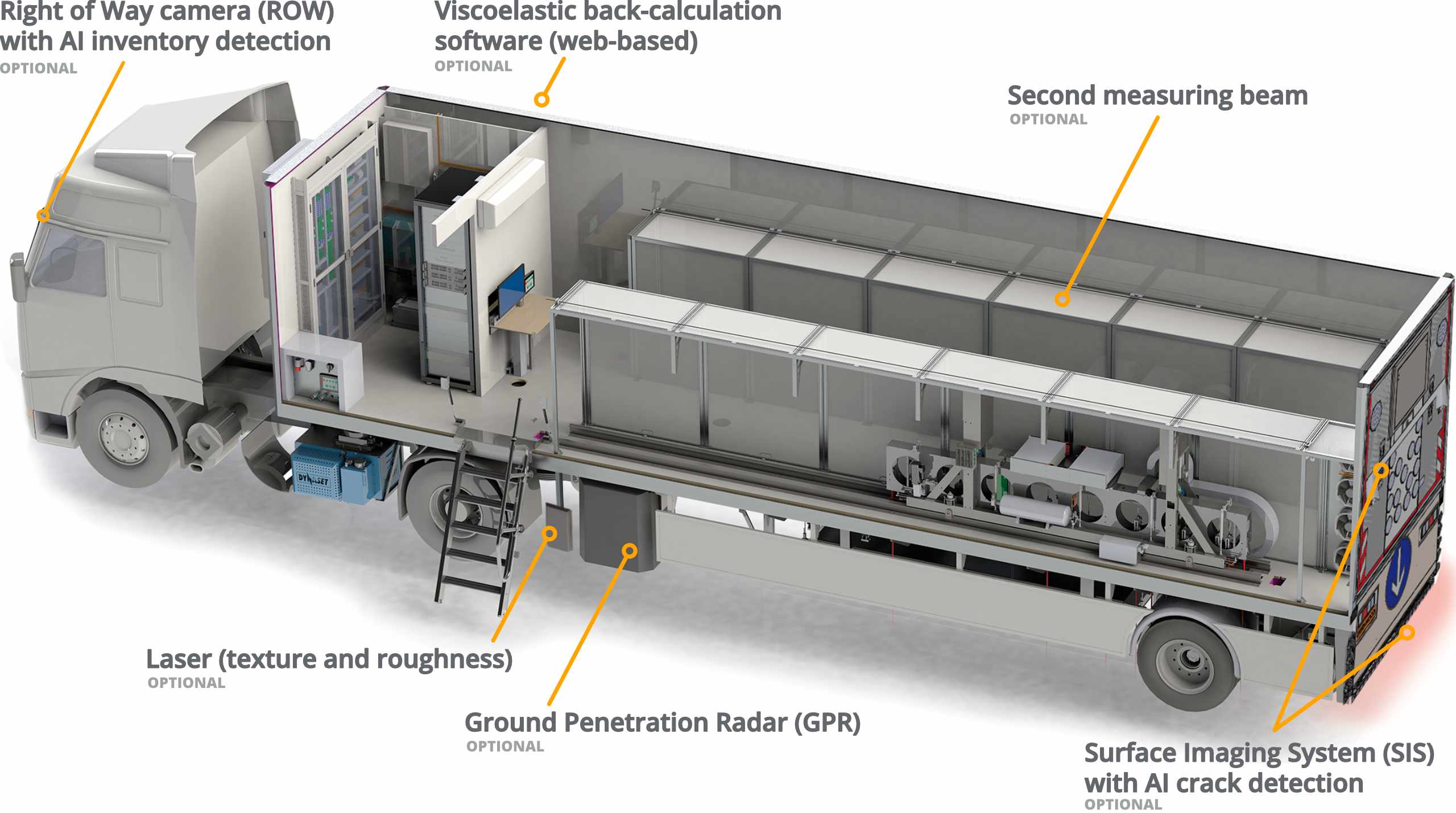Traffic Speed Deflectometer (TSD)
The Traffic Speed Deflectometer (TSD), is an innovative Rolling Wheel Deflectometer measuring pavement response to applied load. The unique TSD technology is developed by Greenwood Engineering and has initiated a shift of paradigm in pavement engineering worldwide.
The Greenwood TSD provides continuous bearing capacity results at project and network level while following the flow of traffic. This makes the Greenwood TSD highly cost-effective.
Synchronized view of your network pavement structural and functional conditions
The TSD provides repeatable, detailed and accurate data, from which bearing capacity indices can be derived and pavement fatigue / residual life can be estimated. This information is essential to decide how and exactly from where to where to repair.
International studies show major savings and more cost-effective road maintenance when plans are based on structural data and focus is kept on repairing the underlying reasons of the road problems, instead of only dealing with the symptoms on the surface.
The TSD quickly identifies the weakest road section, which allows for correct timing in preventive maintenance.
This example is fictional

TSD delivers back-calculated strains down to centimeters
Based on the measured layer thicknesses and pavement response data, the pavement strains and the elastic moduli of each layer can be found using Greenwood’s own viscoelastic back-calculation algorithm.
Having access to detailed back-calculated results at the network level makes it possible to make reliable life-time analyses for the entire road network and to identify appropriate preventative measures in every instance.
When ‘the full picture’ is known for every part of the road network, it is possible to plan pavement maintenance without any unknowns and to use maintenance funds in a truly smart way.
Examples: Fatigue strain with 5 cm intervals. Bearing capacity and the pavement layer thicknesses can be measured in one go.
Continuous measurements up to 80 km/h (50 mph)
with no traffic disruption

Effective calculation of strains and e-moduli from TSD measurements
Greenwood Engineering has developed ViscBackCalc, the world’s first online service capable of running visco-elastic back calculation on TSD measurements for precise prediction of pavement distress at network level. It´s a very fast and easy way to calculate the structural properties of the road network.
ViscBackCalc allows users to upload TSD-measurements and apply visco-elastic back calculation to the entire chainage and download calculated fatique- and rutting strains, e-moduli and slopes. The service also allows for correlation to models derived from FWD. It also generates plots for deflections, slopes and strains and allows for temperature compensation and dynamic layer information e.g. from a ground penetrating radar.
Contact vbc@greenwood.dk for more information or to request access to the service.
Learn more how to get effective calculation of strains and e-moduli from TSD measurements
High efficiency. Low cost.
As the TSD is measuring while following normal traffic speed, it is possible to measure hundreds of kilometers per workday. And because the TSD is operated by only two persons – a driver and an operator – it has no need for assisting personnel closing road lanes or setting up road markings up etc.
This makes the TSD very effective and more economic per measured kilometer compared to traditional point-measuring equipment.

Measuring principle
The Traffic Speed Deflectometer measures the velocity of deflection rather than displacement. To measure the pavement-motion, the TSD uses the principle from the Doppler effect where the movement of a signal-source is creating a change in the wavelength created by the source.
In the TSD, the Doppler lasers are sending out a well described signal, which when reflected from the moving pavement has changed wavelength depending on the pavement velocity.
In this way, road surface texture and roughness, have no influence on the accuracy of bearing capacity measurements with the TSD.
For new TSDs, ten or more Doppler lasers are installed to measure the pavement-motion in front of and behind the load wheel to picture the full deflection bowl.
SCI300 and more. Accurate and repeatable
The TSD provides the full picture of the deflection bowl with well-known values like Surface Curvature Index 300 (SCI 300), maximum deflection (d0) and more. This can be achieved when Doppler lasers are installed both in front of and behind the load wheel and in the longitudinal centerline between the twin tyres of the trailer.
SCITSD is the new structural curvature index for strain analysis of large road networks and airfields developed by Greenwood Engineering. It is well suited for rolling wheel deflection (RWD) experiments as performed by the Traffic Speed Deflectometer.

Example from network measurements
SCITSD vs. tensile strain at the bottom of the top layer. SCITSD is proportional to the strain, since they are both derived from the curvature of the deflection bowl, this means that the tensile strain can be calculated directly from SCITSD shown as the green curve.
Besides the GPR it is possible to include optional equipment as Surface Imaging System (SIS), Right Of Way Camera (ROW) etc. for collection of a full set of synchronised road data in one drive.

Synchronized data from subsystems
Every TSD is uniquely tailored to meet our customers’ needs. Subsystems like the Surface Imaging System, Right-of-way Imaging, Ground Penetrating Radar and similar equipment can be installed to simultaneously collect additional functional data from the road.
Data from these subsystems are synchronized with the structural data in real time, resulting in a set of a big data for the road network – all obtained in one drive.
Excepteur sint occaecat
Lorem ipsum dolor sit amet, consectetur adipiscing elit, sed do eiusmod tempor incididunt ut labore et dolore magna aliqua. Ut enim ad minim veniam, quis nostrud exercitation ullamco laboris nisi ut aliquip ex ea commodo consequat.
Duis aute irure dolor in reprehenderit in voluptate velit esse cillum dolore eu fugiat nulla pariatur. Excepteur sint occaecat cupidatat non proident, sunt in culpa qui officia deserunt mollit anim id est laborum.
Download the articles:
More than 20 TSDs worldwide and counting...
The first TSD was delivered to the Danish Road Directorate under the Ministry of Transport in 2004. Since then, the development has continued and the experience has grown as more than a dozen TSDs are now in operation for various research projects and maintenance optimization tasks in USA, South Africa, Australia, China, England, Germany, Italy, Poland, Sweden and Denmark.
Did you know that the TSD can be employed in airport environments?
The TSD accurately assesses the structural integrity of runways, taxiways, and aprons. This advanced technology enables a comprehensive evaluation, offering a full picture of the runway condition to facilitate informed maintenance decisions, ensuring safety and durability with minimal lane closure.